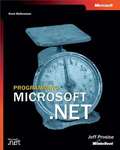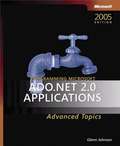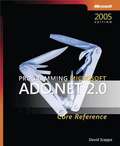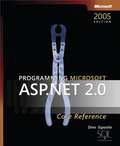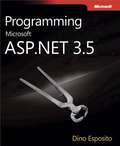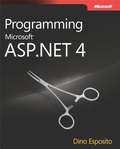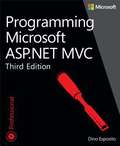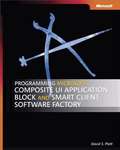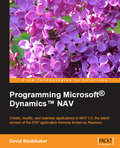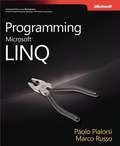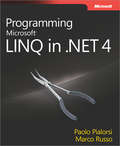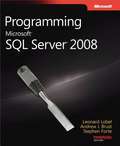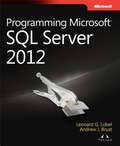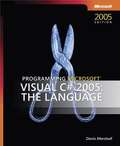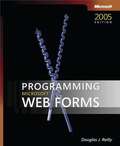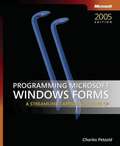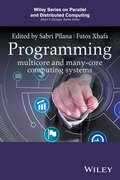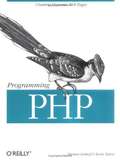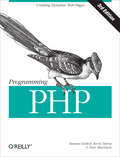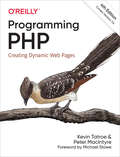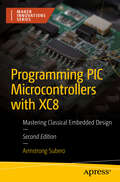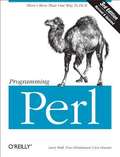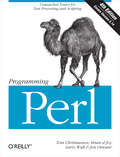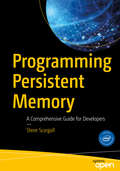- Table View
- List View
Programming Microsoft® .NET
by Jeff ProsiseThe Microsoft .NET initiative builds on industry standards to make interoperable software services available anywhere, on any device, over the Internet. Behind the initiative is the Microsoft .NET Framework, which combines a managed run-time environment with one of the richest class libraries ever invented to make building and deploying Web-enabled applications easier than ever. Find out how to leverage the full power of the .NET Framework with this definitive, one-stop resource, wri tten by a leading authority in his trademark easy-to-follow, conversational style. You'll learn about the key programming models embodied in the .NET Framework, including Windows® Forms, Web Forms, and XML Web services. And you'll benefit from a wealth of how-to examples, code samples, and complete working programs in C#. Topics covered in this guide include: Hello, .NET Types and Exceptions The .NET Framework Class Library Windows Forms Web Forms Web Controls User Controls Custom Controls Web Applications Microsoft ASP.NET Security XML Web Services Microsoft ADO.NET XML Multithreading Remoting CD-ROM FEATURES: A fully searchable electronic version of the book Source code for more than 60 complete sample programs and components written in C# The Microsoft .NET Framework SDK, plus Service Pack 1 A Note Regarding the CD or DVD The print version of this book ships with a CD or DVD. For those customers purchasing one of the digital formats in which this book is available, we are pleased to offer the CD/DVD content as a free download via O'Reilly Media's Digital Distribution services. To download this content, please visit O'Reilly's web site, search for the title of this book to find its catalog page, and click on the link below the cover image (Examples, Companion Content, or Practice Files). Note that while we provide as much of the media content as we are able via free download, we are sometimes limited by licensing restrictions. Please direct any questions or concerns to booktech@oreilly.com.
Programming Microsoft® ADO.NET 2.0 Applications: Advanced Topics
by Glenn JohnsonDive in for reference where you need it--and learn the intricacies of developing sleeker, more robust, security-enhanced applications in ADO.NET 2.0. Featuring code samples in Microsoft Visual C# and Visual Basic, this reference goes beyond the fundamentals to help professional developers solve sophisticated enterprise development problems. Discover how to: Examine advanced connectivity options and best practices--including connection pooling, clustered connections, and asynchronous access Use tracing to diagnose application flow and performance issues Resolve concurrency conflicts and implement a data access layer Implement seamless application failover from one Microsoft SQL Server database to another Use managed code and the SQLCLR to create stored procedures, user-defined functions and types, aggregates, and triggers Write effective data-caching code to improve application performance Use the Systems.Transactions namespace to work with Microsoft SQL Server 2005 Implement streaming techniques to "chunk" data Apply various methods to extract and modify XML data PLUS--Get code samples on the Web
Programming Microsoft® ADO.NET 2.0 Core Reference
by David SceppaBuild your expertise as you move beyond the basics--and delve into the essential topics of programming with ADO.NET 2.0. This comprehensive reference offers expert guidance, hands-on instruction, and code samples in Microsoft Visual C# and Visual Basic to help advance your mastery of developing database applications for Microsoft Windows and the Web. Discover how to: Work with design-time data access features in Microsoft Visual Studio 2005 Use Microsoft .NET Framework 2.0 data providers to connect to databases Build connection strings and enable connection pooling Execute queries, including parameterized and asynchronous queries, and retrieve their results Create DataSet objects to work with offline data and explore common usage scenarios Use the new Common Language Runtime features and XML data type in Microsoft SQL Server 2005 Generate logic and use stored procedures for simple to advanced updating scenarios Design Web applications with new data access features in ASP.NET 2.0--including code-free data-binding capabilities PLUS--Get Visual Basic and C# code samples, and a Microsoft .NET Data Provider on the Web
Programming Microsoft® ASP.NET 2.0 Core Reference
by Dino EspositoBuild your expertise as you move beyond the basics--and delve into the core topics of programming with ASP.NET 2.0. Useful to both experienced developers and those developing new skills, this ultimate reference is packed with expert guidance, hands-on programming instruction, and practical examples to help you advance your mastery of developing applications for the Web. Discover how to: Author rich, visually consistent pages and manage layout with themes and Master pages Create personalized pages that persist user preferences Retrieve, modify, and manage data with Microsoft ADO.NET Configure the HTTP pipeline to serve ASP.NET 2.0 pages Control program flow by tracing and handling exceptions Design caching layers and learn state management techniques to optimize application performance Manage users with membership control, registration, and authentication capabilities Build real-world data access layers using common design patterns Use custom collections with data source controls Learn the internals of grid controls PLUS--Get code samples on the Web
Programming Microsoft® ASP.NET 3.5
by Dino EspositoGet the practical, popular reference written by ASP.NET authority Dino Esposito--now updated for ASP.NET 3.5. An in-depth guide to the core features of Web development with ASP.NET, this book goes beyond the fundamentals. It expertly illustrates the intricacies and uses of ASP.NET 3.5--in a single volume. Part of Microsoft Visual Studio® 2008, ASP.NET 3.5 includes AJAX functionality, the Microsoft SilverlightTM cross-platform development tool, new controls, and new integration features. This pragmatic guide covers these new features, and also includes coverage of Windows® Communication Foundation, LINQ, and other key Microsoft .NET Framework 2.0, 3.0, and 3.5 capabilities. Complete with extensive code samples and code snippets in Microsoft Visual C# 2008, this is the ideal reference for developers who want to learn what's new in ASP.NET 3.5, or for those building professional-level Web development skills.
Programming Microsoft® ASP.NET 4
by Dino EspositoCompletely reengineered for ASP.NET 4--this definitive guide deftly illuminates the core architecture and programming features of ASP.NET 4 in a single, pragmatic volume. Web development expert Dino Esposito provides essential, architectural-level guidance, along with the in-depth technical insights designed to take you--and your solutions--to the next level. The book covers Dynamic Data, AJAX, Microsoft Silverlight®, ASP.NET MVC, Web forms, LINQ, and security strategies--and features extensive code samples in Microsoft Visual C#® 2010.
Programming Microsoft® ASP.NET MVC
by Dino EspositoFully updated for ASP.NET MVC 3. Delve into the features, principles, and pillars of the ASP.NET MVC framework--deftly guided by web development luminary Dino Esposito. ASP.NET MVC forces developers to think in terms of distinct components--Model, View, Controller--that make it easier to manage application complexity, while allowing strict control over the markup. Plunge into the framework's internal mechanics and gain perspectives on how to use this programming model versus Web Forms, and begin building your own MVC-based applications quickly.
Programming Microsoft® Composite UI Application Block and Smart Client Software Factory
by David S. PlattGet practical, hands-on instruction for learning the Composite UI Application Block (CAB) and the Smart Client Software Factory. Using just your fundamental Microsoft Visual Basic or Visual C# skills, you'll work through seven lessons that present real-world scenarios. Each lesson is based on proven classroom guidance--building the skills your need to easily create user interface components for smart-client solutions. Discover how to: Generate a shell application and implement prefabricated or custom CAB services Use work items and controllers to share resources in loosely coupled applications Optimize visual information display by using Workspaces and SmartParts Add and modify menus, toolbars, and status bars by using the CAB user interface extension Announce and receive asynchronous events within an application Invoke methods in the Action Catalog service to coordinate application business-logic Match CAB constructs to Windows Presentation Foundation
Programming Microsoft® Dynamics™ NAV
by David StudebakerFast-paced and to-the-point, this book takes you through the important topics of Microsoft Dynamics NAV with clear explanations and practical example code. The book's selection of topics is driven by what the working developer needs to know in order to become productive as quickly as possible. The business applications software designer/developer who: Wants to become productive in NAV C/SIDE C/AL development as quickly as possible Understands business applications and the associated software Has significant programming experience Has access to NAV including at least the Designer granules, preferably a full development license and a standard Cronus demo database Is willing to do the exercises to get hands-on experience The Reseller manager or executive who wants a concise, in depth view of NAVs development environment and tool set The technically knowledgeable manager or executive of a firm using NAV that is about to embark on a significant NAV enhancement project The technically knowledgeable manager or executive of a firm considering purchase of NAV as a highly customizable business applications platform The reader of this book: Does not need to be expert in object-oriented programming Does not need to have previous experience with NAV
Programming Microsoft® LINQ
by Marco Russo Paolo PialorsiGet comprehensive guidance for using the Microsoft Language Integrated Query (LINQ) Project--with in-depth insights from two experienced developers. Data-rich applications can be difficult to create because of the tremendous differences between query languages used to access data and the programming languages commonly used to write applications. This practical guide covers the intricacies of LINQ, a set of extensions to the Visual C# and Visual Basic programming languages. Instead of traversing different language syntaxes required for accessing data from relational and hierarchical data sources, developers will learn how to write queries natively in Visual C# or Visual Basic--helping reduce complexity and boost productivity. Written by two experienced developers with strong ties to the developer teams at Microsoft, this book describes the LINQ architecture and classes, details the new language features in both Visual C# and Visual Basic, and provides code samples in both languages.
Programming Microsoft® LINQ in Microsoft .NET Framework 4
by Marco Russo Paolo PialorsiDig into LINQ -- and transform the way you work with data. With LINQ, you can query data from a variety of sources -- including databases, objects, and XML files -- directly from Microsoft Visual Basic® or C#. Guided by data-access experts who've worked in depth with LINQ and the Microsoft development teams, you'll learn how .NET Framework 4 implements LINQ, and how to exploit it. Clear examples show you how to deliver your own data-access solutions faster and with leaner code. Discover how to: Use LINQ to query databases, object collections, arrays, XML, Microsoft Excel® files, and other sources Apply LINQ best practices to build data-enabled .NET applications and services Manipulate data in a relational database with ADO.NET Entity Framework or LINQ to SQL Read, write, and manage XML content more efficiently with LINQ to XML Extend LINQ to support additional data sources by creating custom operators and providers Examine other implementations, such as LINQ to SharePoint® Use LINQ within the data, business, and service layers of a distributed application Get code samples on the Web
Programming Microsoft® SQL Server® 2008
by Andrew Brust Leonard Lobel Stephen ForteExtend your programming skills with a comprehensive study of the key features of SQL Server 2008. Delve into the new core capabilities, get practical guidance from expert developers, and put their code samples to work. This is a must-read for Microsoft .NET and SQL Server developers who work with data access--at the database, business logic, or presentation levels. Discover how to: Query complex data with powerful Transact-SQL enhancements Use new, non-relational features: hierarchical tables, native file streaming, and geospatial capabilities Exploit XML inside the database to design XML-aware applications Consume and deliver your data using Microsoft LINQ, Entity Framework, and data binding Implement database-level encryption and server auditing Build and maintain data warehouses Use Microsoft Excel to build front ends for OLAP cubes, and MDX to query them Integrate data mining into applications quickly and effectively Get code samples on the Web.
Programming Microsoft® SQL Server® 2012
by Andrew Brust Leonard LobelYour essential guide to key programming features in Microsoft® SQL Server® 2012 Take your database programming skills to a new level--and build customized applications using the developer tools introduced with SQL Server 2012. This hands-on reference shows you how to design, test, and deploy SQL Server databases through tutorials, practical examples, and code samples. If you're an experienced SQL Server developer, this book is a must-read for learning how to design and build effective SQL Server 2012 applications. Discover how to: Build and deploy databases using the SQL Server Data Tools IDE Query and manipulate complex data with powerful Transact-SQL enhancements Integrate non-relational features, including native file streaming and geospatial data types Consume data with Microsoft ADO.NET, LINQ, and Entity Framework Deliver data using Windows® Communication Foundation (WCF) Data Services and WCF RIA Services Move your database to the cloud with Windows AzureTM SQL Database Develop Windows Phone cloud applications using SQL Data Sync Use SQL Server BI components, including xVelocity in-memory technologies
Programming Microsoft® SQL Server™ 2008
by Andrew Brust Leonard Lobel Stephen Forte<div xmlns="http://www.w3.org/1999/xhtml"><p>Designed for developers and database administrators, this book teaches essential techniques for creating custom database applications and business intelligence solutions with SQL Server 2008.</p></div>
Programming Microsoft® Visual C#® 2005: The Language
by Donis MarshallGet the essential, straightforward information you need to master the core capabilities of Visual C# 2005. Both new and experienced developers get expert guidance, hands-on programming instruction, and practical examples to help advance their proficiency in developing applications for Microsoft Windows and the Web. Discover how to: Refine class usage with inheritance, polymorphism, and other strategies Implement generics to define a type-safe data structure Work with stacks, queues, arrays, dictionaries, and other collections Use iterators to implement and standardize enumerator patterns Know when to catch exceptions--and handle them locally or propagate them Interrogate metadata and facilitate late binding by using reflection Synchronize threads with locks, events, mutexes, and other tools Use the Microsoft Visual Studio Debugger and explore advanced debugging techniques and tools Get code samples on the Web
Programming Microsoft® Web Forms
by Douglas J. ReillyGet the focused, straightforward information you need to master the most common challenges in developing real-world Web Forms applications. Whether you're a new or experienced developer, you'll learn the essential techniques for exploiting new forms and controls in Microsoft ASP.NET 2.0--enabling you to write Web applications more quickly and with less code. Discover how to: Work with standard ASP.NET controls for common tasks Create your own user controls and custom server controls Lay out forms with HTML and Cascading Style Sheets Create common page elements just once with Master Pages Style your Web Forms with themes and skins Add Web Parts and allow users to personalize pages Access and edit data with Microsoft ADO.NET objects Bind data to your form controls--without adding any code Create security-enhanced Web applications Integrate your Web forms with Windows Forms applications PLUS--Get code samples on the Web
Programming Microsoft® Windows® Forms
by Charles PetzoldWhether you're a new or experienced developer, get the focused information you need to streamline application development using Windows Forms and Microsoft .NET Framework 2.0. Award-winning author Charles Petzold illuminates the essential concepts and techniques for exploiting Windows Forms capabilities--offering concise, eloquent instruction as always, along with ample code examples in C#. Discover how to: Understand the architecture of Windows Forms programs Add familiar Windows controls to your application, such as buttons, scroll bars, and text boxes Create toolbars, menus, and status bars, complete with text and bitmap images Enhance existing controls, combine multiple controls, or create custom controls from scratch Exploit dynamic layout with FlowLayoutPanel Support absolute, proportional, or auto-sized columns and rows with TableLayoutPanel Develop data-bound controls Display tabular data with the new DataGridView control--without writing extensive code PLUS--Build and deploy two real-world Windows Forms applications from the bottom up
Programming Multicore and Many-core Computing Systems
by Fatos Xhafa Sabri PllanaProgramming multi-core and many-core computing systems Sabri Pllana, Linnaeus University, Sweden Fatos Xhafa, Technical University of Catalonia, Spain Provides state-of-the-art methods for programming multi-core and many-core systems The book comprises a selection of twenty two chapters covering: fundamental techniques and algorithms; programming approaches; methodologies and frameworks; scheduling and management; testing and evaluation methodologies; and case studies for programming multi-core and many-core systems. Program development for multi-core processors, especially for heterogeneous multi-core processors, is significantly more complex than for single-core processors. However, programmers have been traditionally trained for the development of sequential programs, and only a small percentage of them have experience with parallel programming. In the past, only a relatively small group of programmers interested in High Performance Computing (HPC) was concerned with the parallel programming issues, but the situation has changed dramatically with the appearance of multi-core processors on commonly used computing systems. It is expected that with the pervasiveness of multi-core processors, parallel programming will become mainstream. The pervasiveness of multi-core processors affects a large spectrum of systems, from embedded and general-purpose, to high-end computing systems. This book assists programmers in mastering the efficient programming of multi-core systems, which is of paramount importance for the software-intensive industry towards a more effective product-development cycle. Key features: Lessons, challenges, and roadmaps ahead. Contains real world examples and case studies. Helps programmers in mastering the efficient programming of multi-core and many-core systems. The book serves as a reference for a larger audience of practitioners, young researchers and graduate level students. A basic level of programming knowledge is required to use this book.
Programming PHP
by Rasmus Lerdorf Kevin TatroeProgramming PHPis a comprehensive guide to PHP, a simple yet powerful language for creating dynamic web content. Filled with the unique knowledge of the creator of PHP, Rasmus Lerdorf, this book is a detailed reference to the language and its applications, including such topics as form processing, sessions, databases, XML, and graphics. Covers PHP 4, the latest version of the language.
Programming PHP: Creating Dynamic Web Pages (Apresspod Ser.)
by Rasmus Lerdorf Kevin Tatroe Peter MacintyreProgramming PHP, 2nd Edition, is the authoritative guide to PHP 5 and is filled with the unique knowledge of the creator of PHP (Rasmus Lerdorf) and other PHP experts. When it comes to creating websites, the PHP scripting language is truly a red-hot property. In fact, PHP is currently used on more than 19 million websites, surpassing Microsoft's ASP .NET technology in popularity. Programmers love its flexibility and speed; designers love its accessibility and convenience. As the industry standard book on PHP, all of the essentials are covered in a clear and concise manner. Language syntax and programming techniques are coupled with numerous examples that illustrate both correct usage and common idioms. With style tips and practical programming advice, this book will help you become not just a PHP programmer, but a good PHP programmer. Programming PHP, Second Edition covers everything you need to know to create effective web applications with PHP. Contents include: Detailed information on the basics of the PHP language, including data types, variables, operators, and flow control statements Chapters outlining the basics of functions, strings, arrays, and objects Coverage of common PHP web application techniques, such as form processing and validation, session tracking, and cookies Material on interacting with relational databases, such as MySQL and Oracle, using the database-independent PEAR DB library and the new PDO Library Chapters that show you how to generate dynamic images, create PDF files, and parse XML files with PHP Advanced topics, such as creating secure scripts, error handling, performance tuning, and writing your own C language extensions to PHP A handy quick reference to all the core functions in PHP and all the standard extensions that ship with PHP Praise for the first edition: "If you are just getting into the dynamic Web development world or you are considering migrating from another dynamic web product to PHP, Programming PHP is the book of choice to get you up, running, and productive in a short time." --Peter MacIntrye, eWeek "I think this is a great book for programmers who want to start developing dynamic websites with PHP. It gives a detailed overview of PHP, lots of valuable tips, and a good sense of PHP's strengths." --David Dooling, Slashdot.org
Programming PHP: Creating Dynamic Web Pages (Apresspod Ser.)
by Kevin Tatroe Peter MacIntyreWhy is PHP the most widely used programming language on the web? This updated edition teaches everything you need to know to create effective web applications using the latest features in PHP 7.4. You’ll start with the big picture and then dive into language syntax, programming techniques, and other details, using examples that illustrate both correct usage and common idioms. If you have a working knowledge of HTML, authors Kevin Tatroe and Peter MacIntyre provide many style tips and practical programming advice in a clear and concise manner to help you become a top-notch PHP programmer.Understand what’s possible when you use PHP programsLearn language fundamentals, including data types, variables, operators, and flow control statementsExplore functions, strings, arrays, and objectsApply common web application techniques, such as form processing, data validation, session tracking, and cookiesInteract with relational databases like MySQL or NoSQL databases such as MongoDBGenerate dynamic images, create PDF files, and parse XML filesLearn secure scripts, error handling, performance tuning, and other advanced topicsGet a quick reference to PHP core functions and standard extensions
Programming PIC Microcontrollers with XC8: Mastering Classical Embedded Design (Maker Innovations Series)
by Armstrong SuberoAre you tired of copying and pasting code into your embedded projects? Do you want to write your own code from scratch for microcontrollers and understand what your code is doing without all the frills and math? This book uses a practical approach to show you how to develop embedded systems with 8-bit PIC microcontrollers using the XC8 compiler. Written for those who want more than an Arduino, but less than the more complex microcontrollers on the market, this new edition is fully updated and covers embedded design principles such as foreground-background loops and event driven programming. You’ll learn how to interface with things like Motors, PID loop control and writing a browser-based monitoring system! This book is heavy on code, schematics, and images and focuses less on the theoretical aspects of using microcontrollers. Coverage includes writing a display driver, using the DAC for a multitude of waveform generation techniques, and building 8-bit IoT systems, real time telemetry, a countdown timer, and new peripherals. These topics are important if you want to learn more about PIC microcontroller devices as a whole. You'll also see the advantage that MPLAB X offers by running on Windows, Mac and Linux environments. You don't need to be a command line expert to work with PIC microcontrollers, so you can focus less on setting up your environment and more on your application. If you want to move beyond the Arduino, Programming PIC Microcontrollers with XC8 is your complete guide to understanding modern PIC microcontrollers. What You’ll Learn Set up the MPLAB X and XC8 compilers for microcontroller development Use GPIO and PPS Review EUSART and Software UART communications Use the eXtreme Low Power (XLP) options of PIC microcontrollers Explore wireless communications with WiFi and Bluetooth Who This Book Is For Those with basic electronic device and electronic equipment experience and some knowledge of the C programming and digital electronics. Also targeted towards students wanting a practical overview of microcontrollers outside of the classroom.
Programming Perl
by Tom Christiansen Jon Orwant Larry WallPerl is a powerful programming language that has grown in popularity since it first appeared in 1988. The first edition of this book, Programming Perl, hit the shelves in 1990, and was quickly adopted as the undisputed bible of the language. Since then, Perl has grown with the times, and so has this book. Programming Perl is not just a book about Perl. It is also a unique introduction to the language and its culture, as one might expect only from its authors. Larry Wall is the inventor of Perl, and provides a unique perspective on the evolution of Perl and its future direction. Tom Christiansen was one of the first champions of the language, and lives and breathes the complexities of Perl internals as few other mortals do. Jon Orwant is the editor of The Perl Journal, which has brought together the Perl community as a common forum for new developments in Perl. Any Perl book can show the syntax of Perl's functions, but only this one is a comprehensive guide to all the nooks and crannies of the language. Any Perl book can explain typeglobs, pseudohashes, and closures, but only this one shows how they really work. Any Perl book can say that my is faster than local, but only this one explains why. Any Perl book can have a title, but only this book is affectionately known by all Perl programmers as "The Camel." This third edition of Programming Perl has been expanded to cover version 5.6 of this maturing language. New topics include threading, the compiler, Unicode, and other new features that have been added since the previous edition.
Programming Perl: Unmatched power for text processing and scripting
by Tom Christiansen Jon Orwant Larry Wall Brian D FoyAdopted as the undisputed Perl bible soon after the first edition appeared in 1991, Programming Perl is still the go-to guide for this highly practical language. Perl began life as a super-fueled text processing utility, but quickly evolved into a general purpose programming language that’s helped hundreds of thousands of programmers, system administrators, and enthusiasts, like you, get your job done.In this much-anticipated update to "the Camel," three renowned Perl authors cover the language up to its current version, Perl 5.14, with a preview of features in the upcoming 5.16. In a world where Unicode is increasingly essential for text processing, Perl offers the best and least painful support of any major language, smoothly integrating Unicode everywhere—including in Perl’s most popular feature: regular expressions.Important features covered by this update include:New keywords and syntaxI/O layers and encodingsNew backslash escapesUnicode 6.0Unicode grapheme clusters and propertiesNamed captures in regexesRecursive and grammatical patternsExpanded coverage of CPANCurrent best practices
Programming Persistent Memory: A Comprehensive Guide for Developers
by Steve ScargallBeginning and experienced programmers will use this comprehensive guide to persistent memory programming. You will understand how persistent memory brings together several new software/hardware requirements, and offers great promise for better performance and faster application startup times—a huge leap forward in byte-addressable capacity compared with current DRAM offerings. This revolutionary new technology gives applications significant performance and capacity improvements over existing technologies. It requires a new way of thinking and developing, which makes this highly disruptive to the IT/computing industry. The full spectrum of industry sectors that will benefit from this technology include, but are not limited to, in-memory and traditional databases, AI, analytics, HPC, virtualization, and big data. Programming Persistent Memory describes the technology and why it is exciting the industry. It covers the operating system and hardware requirements as well as how to create development environments using emulated or real persistent memory hardware. The book explains fundamental concepts; provides an introduction to persistent memory programming APIs for C, C++, JavaScript, and other languages; discusses RMDA with persistent memory; reviews security features; and presents many examples. Source code and examples that you can run on your own systems are included. What You’ll LearnUnderstand what persistent memory is, what it does, and the value it brings to the industryBecome familiar with the operating system and hardware requirements to use persistent memoryKnow the fundamentals of persistent memory programming: why it is different from current programming methods, and what developers need to keep in mind when programming for persistenceLook at persistent memory application development by example using the Persistent Memory Development Kit (PMDK)Design and optimize data structures for persistent memoryStudy how real-world applications are modified to leverage persistent memoryUtilize the tools available for persistent memory programming, application performance profiling, and debugging Who This Book Is ForC, C++, Java, and Python developers, but will also be useful to software, cloud, and hardware architects across a broad spectrum of sectors, including cloud service providers, independent software vendors, high performance compute, artificial intelligence, data analytics, big data, etc.
